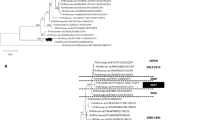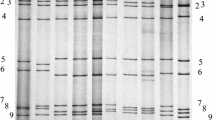Abstract
Species A rotaviruses (RVAs) have been recognized as one of the leading causes of acute gastroenteritis in humans worldwide. Here, the complete coding sequences of 11 RNA segments of an uncommon G9P[4] RVA strain, which was detected in feces of a diarrheal child in Japan, were determined by next-generation sequencing technology. Its genomic constellation, VP7-VP4-VP6-VP1-VP2-VP3-NSP1-NSP2-NSP3-NSP4-NSP5, was determined as G9-P[4]-I2-R2-C2-M2-A2-N2-T2-E2-H2. This work reports the complete coding sequences of a G9P[4] RVA strain containing DS-1-like (genotype 2) genes that was isolated in Japan in 2013.

Similar content being viewed by others
Data availability
The GenBank accession numbers for the complete coding regions of all 11 segments of strain RVA/Human-wt/JPN/11584/2013/G9P[4] are OM301627- OM301637.
References
Bishop RF, Davidson GP, Holmes IH, Ruck BJ (1973) Virus particles in epithelial cells of duodenal mucosa from children with acute non-bacterial gastroenteritis. Lancet 2:1281–1283
Johne R, Schilling-Loeffler K, Ulrich RG, Tausch HS (2022) Whole genome sequence analysis of a prototype strain of the novel putative rotavirus species L. Viruses 14:462
Dennehy PH (2015) Rotavirus infection: a disease of the past? Infect Dis Clin North Am 29:617–635
Esona MD, Gautam R (2015) Rotavirus. Clin Lab Med 35:363–391
Troeger C, Khalil IA, Rao PC, Cao S, Blacker BF, Ahmed T, Armah G, Bines JE, Brewer TG, Colombara DV, Kang G, Kirkpatrick BD, Kirkwood CD, Mwenda JM, Parashar UD, Petri WA Jr, Riddle MS, Steele AD, Thompson RL, Walson JL, Sanders JW, Mokdad AH, Murray CJL, Hay SI, Reiner RC Jr (2018) Rotavirus vaccination and the global burden of rotavirus diarrhea among children younger than 5 years. JAMA Pediatr 172:958–965
Dóró R, László B, Martella V, Leshem E, Gentsch J, Parashar U, Bányai K (2014) Review of global rotavirus strain prevalence data from six years post vaccine licensure surveillance: is there evidence of strain selection from vaccine pressure? Infect Genet Evol 28:446–461
Matthijnssens J, Heylen E, Zeller M, Rahman M, Lemey P, Ranst VM (2010) Phylodynamic analyses of rotavirus genotypes G9 and G12 underscore their potential for swift global spread. Mol Biol Evol 27:2431–2436
Yamamoto SP, Kaida A, Ono A, Kubo H, Iritani N (2015) Detection and characterization of a human G9P[4] rotavirus strain in Japan. J Med Virol 87:1311–1318
Phan TG, Khamrin P, Quang TD, Dey SK, Takanashi S, Okitsu S, Maneekarn N, Ushijima H (2007) Detection and genetic characterization of group A rotavirus strains circulating among children with acute gastroenteritis in Japan. J Virol 81:4645–4653
Kamiya H, Tacharoenmuang R, Ide T, Negoro M, Tanaka T, Asada K, Nakamura H, Sugiura K, Umemoto M, Kuroki H, Ito H, Tanaka S, Ito M, Fukuda S, Hatazawa R, Hara Y, Guntapong R, Murata T, Taniguchi K, Suga S, Nakano T, Taniguchi K, Komoto S (2019) Characterization of an unusual DS-1-like G8P[8] rotavirus strain from Japan in 2017: Evolution of emerging DS-1-Like G8P[8] strains through reassortment. Jpn J Infect Dis 72:256–260
Kudo S, Zhou Y, Cao XR, Yamanishi S, Nakata S, Ushijima H (2001) Molecular characterization in the VP7, VP4 and NSP4 genes of human rotavirus serotype 4 (G4) isolated in Japan and Kenya. Microbiol Immunol 45:167–171
Abe M, Ito N, Masatani T, Nakagawa K, Yamaoka S, Kanamaru Y, Suzuki H, Shibano K, Arashi Y, Sugiyama M (2011) Whole genome characterization of new bovine rotavirus G21P[29] and G24P[33] strains provides evidence for interspecies transmission. J Gen Virol 92:952–960
Matthijnssens J, Ciarlet M, Rahman M, Attoui H, Bányai K, Estes MK, Gentsch JR, Iturriza-Gómara M, Kirkwood CD, Martella V, Mertens PP, Nakagomi O, Patton JT, Ruggeri FM, Saif LJ, Santos N, Steyer A, Taniguchi K, Desselberger U, Van Ranst M (2003) Recommendations for the classification of group A rotaviruses using all 11 genomic RNA segments. Arch Virol 153:1621–1629
Matthijnssens J, Ciarlet M, Heiman E, Arijs I, Delbeke T, McDonald SM, Palombo EA, Iturriza-Gómara M, Maes P, Patton JT, Rahman M, Van Ranst M (2008) Full genome-based classification of rotaviruses reveals a common origin between human Wa-like and porcine rotavirus strains and human DS-1-like and bovine rotavirus strains. J Virol 82:3204–3219
Maes P, Matthijnssens J, Rahman M, Van Ranst M (2009) RotaC: a web-based tool for the complete genome classification of group A rotaviruses. BMC Microbiol 9:238
Tamura K, Stecher G, Peterson D, Filipski A, Kuman S (2013) MEGA6: Molecular evolutionary genetics analysis version 6.0. Mol Biol Evol 30:2725–2729
Santos N, Volotão EM, Soares CC, Albuquerque MC, da Silva FM, de Carvalho TR, Pereira CF, Chizhikov V, Hoshino Y (2001) Rotavirus strains bearing genotype G9 or P[9] recovered from Brazilian children with diarrhea from 1997 to 1999. J Clin Microbiol 39:1157–1160
Quaye O, McDonald S, Esona MD, Lyde FC, Mijatovic-Rustempasic S, Roy S, Banegas DJ, Quiñonez YM, Chinchilla BL, Santiago FG, Lozano HG, Rey-Benito G, de Oliveira LH, Gentsch JR, Bowen MD (2013) Rotavirus G9P[4] in 3 countries in Latin America, 2009–2010. Emerg Infect Dis 19:1332–1333
Chitambar SD, Ranshing SS, Pradhan GN, Kalrao VR, Dhongde RK, Bavdekar AR (2014) Changing trends in circulating rotavirus strains in Pune, western India in 2009–2012: emergence of a rare G9P[4] rotavirus strain. Vaccine 11(32 Suppl 1):A29-32
Lewis J, Roy S, Esona MD, Mijatovic-Rustempasic S, Hardy C, Wang Y, Cortese M, Bowen MD (2014) Full genome sequence of a reassortant human G9P[4] rotavirus strain. Genome Announc 2:e01284-e1314
Moutelíková R, Sauer P, Prodělalová J (2020) Whole-genome sequence of a reassortant G9P[4] rotavirus A strain from two children in the Czech Republic. Arch Virol 165:1703–1706
Doan YH, Suzuki Y, Fujii Y, Haga K, Fujimoto A, Takai-Todaka R, Someya Y, Nayak MK, Mukherjee A, Imamura D, Shinoda S, Chawla-Sarkar M, Katayama K (2017) Complex reassortment events of unusual G9P[4] rotavirus strains in India between 2011 and 2013. Infect Genet Evol 54:417–428
Acknowledgements
We thank Ms. Onda-Shimizu Yuko for her technical help. This study was supported by Grants-in-Aid for Japan Agency for Medical Research and Development (AMED ) under grant numbers JP22fk0108122 and JP22wm0225006.
Funding
This study was supported by Grants-in-Aid for Japan Agency for Medical Research and Development (AMED ) under grant numbers JP22fk0108122 and JP22wm0225006.
Author information
Authors and Affiliations
Contributions
Hiroshi Ushijima, Satoshi Komoto, Takashi Kobayashi, and Niwat Maneekarn designed the study. Riona Hatazawa, Ngan Thi Kim Pham, Pattara Khamrin, and Satoshi Hayakawa performed experiments. Tung Phan, Shoko Okitsu, and Hiroshi Ushijima wrote the manuscript. Shuichi Nishimura provided the specimen. All authors read and approved the final manuscript.
Corresponding author
Ethics declarations
Conflict of interest
The authors have no relevant financial or non-financial interests to disclose.
Research involving human participants and/or animals
The study was approved by the ethics committee of Nihon University (29-9-0, 29-9-1).
Informed consent
Informed consent was obtained from the patient’s parents.
Additional information
Handling Editor: Tim Skern.
Publisher's Note
Springer Nature remains neutral with regard to jurisdictional claims in published maps and institutional affiliations.
Supplementary Information
Below is the link to the electronic supplementary material.
Rights and permissions
About this article
Cite this article
Phan, T., Hatazawa, R., Komoto, S. et al. Whole genome sequence of an uncommon G9P[4] species A rotavirus containing DS-1-like (genotype 2) genes in Japan. Arch Virol 167, 1603–1606 (2022). https://doi.org/10.1007/s00705-022-05462-2
Received:
Accepted:
Published:
Issue Date:
DOI: https://doi.org/10.1007/s00705-022-05462-2




